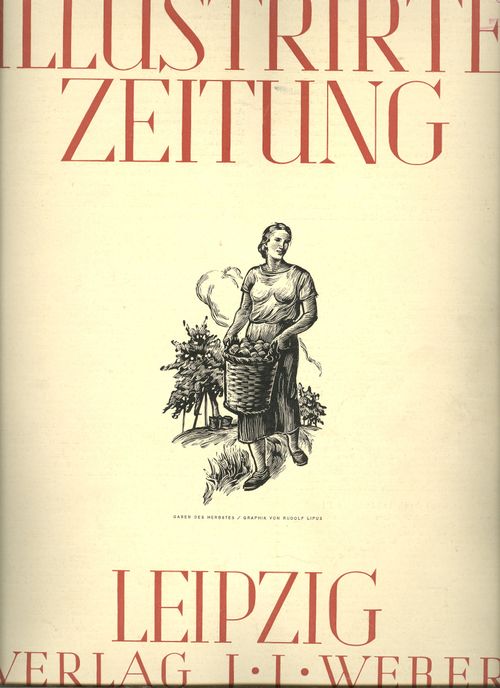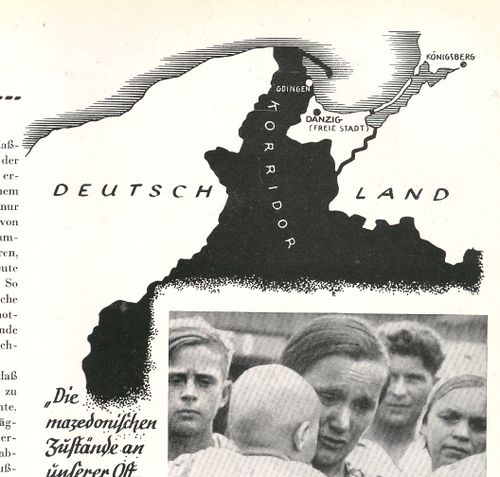JF Ptak Science Books LLC Post 739 Blog Bookstore
There's a war on? Really? You wouldn't know it from the cover page of the most popular magazine in Germany, the (Leipzig) Illustrirte Zeitung, published 7 September 1939. The odd thing is that for months, years, previously there was a huge and occasionally overwhelming militaria scent to this magazine (a sort of LIFE magazine-like affair in its way), paving the way for the reading population (which I'm sure must've been in the millions) for the stuff to come. I've looked at every issue of this magazine from 1933 to 1939, and there is simply no mistaking the under- and over-current of the war preparation. It was just relentless. And so to finally come to the real fighting part of the beginning of the war it is a little odd to see the cover of the mag decorated with Mother Earth in the herb garden. The contents of the issue is not what I expected either--not much dedicated to fighting outside of happy and relieved Gdanskers saluting their warm welcome to the advancing Nazi machine, images of the "mongrels" who were living in the places that had once been occupied by Germans, and an "apology" of sorts as to why all of this was necessary.All of which was bluster and diatribe--its hard to imagine, really, how someone living in Leipzig reading this thing over breakfast could've nodded their head in logical consent with the magazine's specious arguments.
Which brings us to the small inset map depicting what was one of the major "problems" for Germany with Poland--the northern stretch of Polish land that touched the Baltic, the so-called Polish "Corridor". This polemical affair shows exactly what the Germans thought of the territory, a piece of Germany now in enemy hands, a dagger struck through the heart of Prussia.
 Poland of course didn't think of the land in terms of a "corridor", and as a matter of fact the term was an offensive one. It was simply a part of Poland, one which was returned to the Poles with the rest of the country (which had been disappeared, absorbed, with the Treaty of Vienna in 1815) in 1920. It was essential with repatriation that this land be included, giving Poland a natural access to the Baltic, and an ability to follows it major river (the Vistula) all the way to the sea. Without access to the Baltic, Poland's economy would have been strangled, the country simply wouldn't have had a good stake to survival. It was a return of land that had been connected to the Polish Crown from 1466-1772.
Poland of course didn't think of the land in terms of a "corridor", and as a matter of fact the term was an offensive one. It was simply a part of Poland, one which was returned to the Poles with the rest of the country (which had been disappeared, absorbed, with the Treaty of Vienna in 1815) in 1920. It was essential with repatriation that this land be included, giving Poland a natural access to the Baltic, and an ability to follows it major river (the Vistula) all the way to the sea. Without access to the Baltic, Poland's economy would have been strangled, the country simply wouldn't have had a good stake to survival. It was a return of land that had been connected to the Polish Crown from 1466-1772.
The ethnicity issues are long and deep, and something I can't get into right here. But Germany certainly made the claim that there were huge German populations in the corridor who needed to be rescued, and who suffered under the control of the inferior Polish people. But as I said, this is a complex issue--the population in the area was probably around 45% in 1920, and this before the huge repatriation efforts to bring those German people home. There may have been so many Germans in that area because of a massive Germanization of the area in the 19th century...and on and on.
The Polish government did sign a Non-Aggression Pact with Germany in 1934, after which everything got on the slow boat to hell. In the months before the Germans attacked, through the summer, there was much frenzied back-and-forth, an awful lot of negotiations that were so much meaningless talk as a mask for the inevitable. Whatever was agreed upon and signed, Germany was going to attack, anyway, come what may. And so they did.
[I should point out in closing that, just a few days ago, the Airminded.org site reminded us all of H.G. Wells' 1933 The Shape of Things to Come, and his prediction on the start (or re-start) of the next great war, right there at the Polish "corridor", and right soon.]



Comments